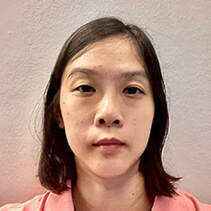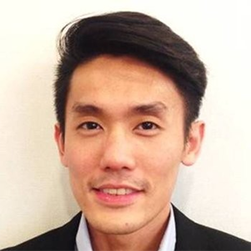|
Date: 21 Sept 2021
Time: 11am - 12pm Topic: Panel discussion "Cell and Gene Therapy" Format: Zoom Meeting (registration is required) Hosted by: Adrian Teo, IMCB & ExCo SCSS Alvin Soetedjo, IMCB |
Panelists' information
Abstract
Mesenchymal stem cells have shown promise in various therapeutic applications. Celligenics is currently focused on mesenchymal stem cells from the umbilical cord (UCSC). These cells are preferred over adipose or bone marrow MSCs as they offer several advantages. However, direct use of cells poses technical and logistical challenges, and Celligenics has focused on using UCSC-derived secretome instead. Our initial application is in wound healing and research data suggests that our secretome can significantly accelerate this process. Regardless, using secretome also comes with its own challenges, including manufacturing and regulatory hurdles.
Bio
Pamela Mok joined Celligenics as head of R&D when it was incorporated in 2016. Her team conducts the research and product development, which focuses on utilizing adult stem cells and their derivatives in therapeutics and other applications. Prior to joining Celligenics, Pamela received her Ph.D in Pharmacology from the National University of Singapore and did her postdoctoral studies at University of California San Francisco and the Institute of Medical Biology at A*STAR.
Mesenchymal stem cells have shown promise in various therapeutic applications. Celligenics is currently focused on mesenchymal stem cells from the umbilical cord (UCSC). These cells are preferred over adipose or bone marrow MSCs as they offer several advantages. However, direct use of cells poses technical and logistical challenges, and Celligenics has focused on using UCSC-derived secretome instead. Our initial application is in wound healing and research data suggests that our secretome can significantly accelerate this process. Regardless, using secretome also comes with its own challenges, including manufacturing and regulatory hurdles.
Bio
Pamela Mok joined Celligenics as head of R&D when it was incorporated in 2016. Her team conducts the research and product development, which focuses on utilizing adult stem cells and their derivatives in therapeutics and other applications. Prior to joining Celligenics, Pamela received her Ph.D in Pharmacology from the National University of Singapore and did her postdoctoral studies at University of California San Francisco and the Institute of Medical Biology at A*STAR.
Abstract
STEMCELL Technologies is dedicated to improving lives through scientific research. The company provides a broad range of high quality and innovative research tools to isolate and culture specialized cells that are used in cell therapy research and manufacturing. Jeremy will elaborate on the investment and initiatives the company has committed to provide higher regulatory compliance products and support for cellular therapies. He will also share on how STEMCELL Technologies actively contributes to scientific progress by engaging in research collaborations with academic, industry, and government partners around the world.
Bio
Jeremy is the Regional Sales Manager for Singapore and SEA. His direct sales team in Singapore supports scientists in the academic labs, hospitals, biopharma, biotechnology start-ups and routine diagnostic labs. He trains and works with distributors to support and grow the rest of SEA business. Over his 10 years of commercial career in the life science sector, he has taken on different roles in sales, product education, technical support and business development. His experience spans across regenerative medicine, immune cell therapies and precision medicine. He obtained his PhD in Biomedical Sciences at the Menzies Institute for Medical Research, University of Tasmania, Australia and BSc (Hons) in Life Sciences at the National University of Singapore.
STEMCELL Technologies is dedicated to improving lives through scientific research. The company provides a broad range of high quality and innovative research tools to isolate and culture specialized cells that are used in cell therapy research and manufacturing. Jeremy will elaborate on the investment and initiatives the company has committed to provide higher regulatory compliance products and support for cellular therapies. He will also share on how STEMCELL Technologies actively contributes to scientific progress by engaging in research collaborations with academic, industry, and government partners around the world.
Bio
Jeremy is the Regional Sales Manager for Singapore and SEA. His direct sales team in Singapore supports scientists in the academic labs, hospitals, biopharma, biotechnology start-ups and routine diagnostic labs. He trains and works with distributors to support and grow the rest of SEA business. Over his 10 years of commercial career in the life science sector, he has taken on different roles in sales, product education, technical support and business development. His experience spans across regenerative medicine, immune cell therapies and precision medicine. He obtained his PhD in Biomedical Sciences at the Menzies Institute for Medical Research, University of Tasmania, Australia and BSc (Hons) in Life Sciences at the National University of Singapore.
Abstract
Mutations in the LMNA gene cause many diseases, including dilated cardiomyopathy (DCM), muscular dystrophies, lipodystrophy and progeria. The lamins maintain nuclear shape, protect the nucleus from mechanical stresses and tether the nucleus to the cytoskeleton through the LINC complex, providing a direct physical link between the cell surface/ECM and nucleoplasm. Lmna DCM and progeria mutations result in elevated levels of the LINC complex component SUN1. Mice die within one month from Lmna induced heart failure; however, deleting Sun1 in these mice results in their survival for more than one year. We developed a dominant-negative SUN1 minigene that, by AAV mediated delivery into DCM hearts, significantly ameliorates many of the Lmna induced cardiac muscle pathologies. The DNSUN1 is now being developed as a potential therapeutic for treating patients with DCM.
Mutations in the LMNA gene cause many diseases, including dilated cardiomyopathy (DCM), muscular dystrophies, lipodystrophy and progeria. The lamins maintain nuclear shape, protect the nucleus from mechanical stresses and tether the nucleus to the cytoskeleton through the LINC complex, providing a direct physical link between the cell surface/ECM and nucleoplasm. Lmna DCM and progeria mutations result in elevated levels of the LINC complex component SUN1. Mice die within one month from Lmna induced heart failure; however, deleting Sun1 in these mice results in their survival for more than one year. We developed a dominant-negative SUN1 minigene that, by AAV mediated delivery into DCM hearts, significantly ameliorates many of the Lmna induced cardiac muscle pathologies. The DNSUN1 is now being developed as a potential therapeutic for treating patients with DCM.
BIO
Colin Stewart has been a pioneer in developing many of the techniques now widely used in mouse experimental genetics, in establishing protocols for deriving embryonic stem (ES) lines, uniparental ES lines, and for the derivation of the first human ES lines. He was instrumental in identifying the cytokine LIF as being crucial to sustaining stem cell pluripotency (Nature 1988 v336: p684). Subsequently he showed that LIF and its signalling pathway is critical to regulating uterine receptivity for embryo implantation in mammals (Nature 1992 v359: p76). He developed numerous mouse models of human congenital diseases, particularly those arising from defective genomic imprinting such as Prader-Willi.
Over the last decade his interests have centered on the laminopathies, a heterogeneous collection of diseases all arising from mutations in the LaminA gene that cause cardiovascular disease, muscular dystrophy, lipodystrophy (reduced fat formation) and the premature ageing disease Hutchinson Gilford Progeria (HGPS). He collaborated with Nicolas Lévy, in being the first to show that mutations in the LMNA gene cause Progeria (Science 2003 v336: p684), and has also made mouse models of many of the laminopathies, including progeria. He developed the first iPSCs lines derived from patient fibroblasts in establishing an in vitro model for HGPS. Currently, he is a founding partner of Neuvocor Therapeutics that is developing new treatments to ameliorate cardiomyopathies and vascular disease.
Colin Stewart has been a pioneer in developing many of the techniques now widely used in mouse experimental genetics, in establishing protocols for deriving embryonic stem (ES) lines, uniparental ES lines, and for the derivation of the first human ES lines. He was instrumental in identifying the cytokine LIF as being crucial to sustaining stem cell pluripotency (Nature 1988 v336: p684). Subsequently he showed that LIF and its signalling pathway is critical to regulating uterine receptivity for embryo implantation in mammals (Nature 1992 v359: p76). He developed numerous mouse models of human congenital diseases, particularly those arising from defective genomic imprinting such as Prader-Willi.
Over the last decade his interests have centered on the laminopathies, a heterogeneous collection of diseases all arising from mutations in the LaminA gene that cause cardiovascular disease, muscular dystrophy, lipodystrophy (reduced fat formation) and the premature ageing disease Hutchinson Gilford Progeria (HGPS). He collaborated with Nicolas Lévy, in being the first to show that mutations in the LMNA gene cause Progeria (Science 2003 v336: p684), and has also made mouse models of many of the laminopathies, including progeria. He developed the first iPSCs lines derived from patient fibroblasts in establishing an in vitro model for HGPS. Currently, he is a founding partner of Neuvocor Therapeutics that is developing new treatments to ameliorate cardiomyopathies and vascular disease.
Abstract
HSA has promulgated new regulations for cell, tissue and gene therapy products (CTGTP) under the Health Products Act. It is a fit-for-purpose regulatory framework that will facilitate product development from clinical trials, manufacturing (both commercial and healthcare institutions) and registration, including long term follow-up for safety and efficacy of novel and innovative CTGTP.
HSA has promulgated new regulations for cell, tissue and gene therapy products (CTGTP) under the Health Products Act. It is a fit-for-purpose regulatory framework that will facilitate product development from clinical trials, manufacturing (both commercial and healthcare institutions) and registration, including long term follow-up for safety and efficacy of novel and innovative CTGTP.
Bio
Dr. Srinivasan KELLATHUR is currently Director, Advanced Therapy Products Branch at Singapore Health Sciences Authority where his work involves policy reviews, drafting of regulations and guidelines, and marketing authorisation of cell, tissue and gene therapy products. He is also the Adjunct Assistant Professor at the Duke-NUS Centre of Regulatory Excellence. He is a co-lead for the regulatory convergence initiatives for advanced therapy products priority work area under the auspices of APEC regulatory harmonization steering committee. Srini sits on several national and international committees. He holds PhD from National University of Singapore and his post-doctoral research was from the Johns Hopkins University School of Medicine.
Dr. Srinivasan KELLATHUR is currently Director, Advanced Therapy Products Branch at Singapore Health Sciences Authority where his work involves policy reviews, drafting of regulations and guidelines, and marketing authorisation of cell, tissue and gene therapy products. He is also the Adjunct Assistant Professor at the Duke-NUS Centre of Regulatory Excellence. He is a co-lead for the regulatory convergence initiatives for advanced therapy products priority work area under the auspices of APEC regulatory harmonization steering committee. Srini sits on several national and international committees. He holds PhD from National University of Singapore and his post-doctoral research was from the Johns Hopkins University School of Medicine.




